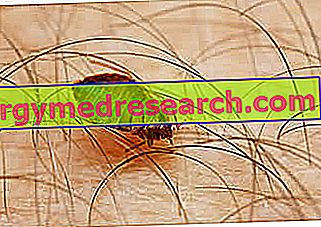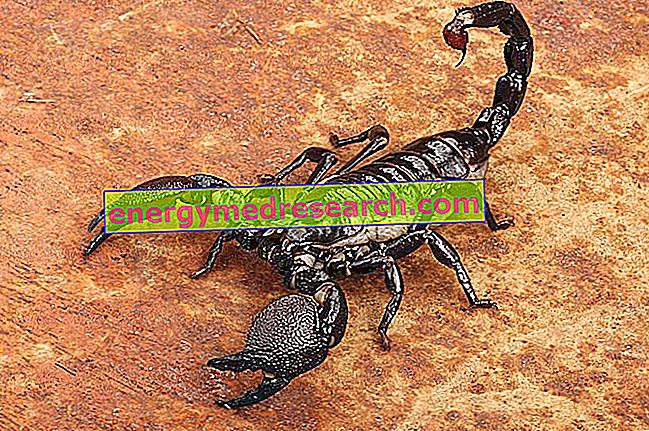Generality
Parasites are organisms that depend on other organisms (the so-called "guests"), since they draw from them the nutrients they need for their own survival, growth and reproduction.

According to experts, in nature, there are 3 main classes of parasites that cause disease in humans: the class of protozoa, the class of helminths and the class of ectoparasites.
Protozoa are single-celled microorganisms that live within the host; helminths are worm-like multicellular organisms; finally, ectoparasites are multicellular organisms that parasite the host from the outside.
What are parasites?
Parasites are organisms that live at the expense of other organisms (so-called " host " organisms), drawing from them the nutrients they need to survive, grow and reproduce.
With regard to host organisms, some parasites are responsible for more or less serious diseases.
MEANING OF PARASITOSIS
Before describing the most important classes of parasites present in nature, it is good to bring to the attention of readers the meaning of parasitosis .
Parasitosis is the medical term for an infectious disease transmitted or caused by parasitic organisms.
ORIGIN OF THE PARASITE TERM
The word "parasite" derives from the Greek word " parasitos " ( παράσιτος ), which in Italian can be translated as "the one who eats at the table of another ".
By breaking down the term parasitos, this is composed of:
- Parà ( παρά ), which means "next", and
- Sitos ( σῖτος ), which means "food".
Classes
In nature, there are three main classes of parasites that cause disease in humans.
These classes of parasites are:
- Protozoa
- The helminths
- Ectoparasites
The protozoa and helminths that live specifically within the host are also called endoparasites, or " interior parasites " (NB: the prefix "endo" comes from the Greek word " éndon " which means "inside" or "inside" ).
PROTOZOA
Protozoa are a heterogeneous group of unicellular eukaryotic microorganisms, widespread in almost all types of habitats, from the ground and the deepest sea to freshwater basins.
They are heterotrophic, that is organisms that draw energy and other compounds, feeding on organic substances processed by other organisms.
Microbiologists have estimated that, in nature, there are more than 50, 000 different species of protozoa and have observed that the best criterion for distinguishing the aforementioned large number of species is the mode of displacement in the environment.
Based on the modes of movement used by the protozoa, these microorganisms can be divided into four large groups:
- The group of ciliated protozoa . To move, they make use of cilia, ie hair-like structures that line the outer surface of the protozoan cell.
Some examples: Balantidium coli and Paramecium .
- The group of flagellated protozoa . To move, they use one or more flagella, which, in fact, are very large and elongated cilia.
Some examples: Giardia lamblia, Trypanosoma brucei, Trypanosoma cruzi and Trichomonas vaginalis .
- The group of amoeboid protozoa . To perform their movements, they resort to extroflexions of the plasma membrane, which in technical jargon are called pseudopods.
Through the pseudopods, the amoeboid protozoa are also able to incorporate the nutrients that are found in the environment.
Some examples: Entamoeba histolytica and Acanthamoeba .
- The group of prorozoa sporozoa . Lack of movement structures. This has made them powerful parasites, as they are forced to live on what their surroundings provide.
Some examples: Plasmodium knowlesi, Plasmodium malariae and Toxoplasma gondii .
The human being lives every day in contact with the protozoa, but this does not mean that it is parasitized or is at risk of parasitosis.
In most cases, in fact, the close protozoan-human relationship has no consequences on human health; any problems that may arise are generally due to a decrease in the immune system, that is to say the defensive system that protects the organism from infectious microorganisms and other threats.

When they can infect an individual, pathogenic protozoa have a general tendency to lurk in the intestine.
Among the most known diseases caused by pathogenic protozoa, are:
- Malaria → causative agent: Plasmodium malariae, from the group of protozoa sporozoa.
- Amebiasis → causative agent: Entamoeba histolytica, from the group of amoeboid protozoa.
- Amoebic dysentery → causative agent: Entamoeba histolytica, of the group of amoeboid protozoa.
- Giardiasis → causative agent: Giardia lamblia, from the group of flagellated protozoa.
- Toxoplasmosis → causative agent: Toxoplasmosis gondii, from the group of protozoan sporozoa.
- Human leishmaniasis → causative agent: Leishmania, from the group of flagellated protozoa.
- Trichomoniasis → causative agent: Trichomonas vaginalis, from the group of flagellated protozoa.
- Chagas disease → causative agent: Trypanosoma cruzi, from the group of flagellated protozoa.
- African trypanosomiasis → causative agent : Trypanosoma, from the group of flagellated protozoa.
- Primary amoebic meningoencephalitis → causative agent: Acanthamoeba, of the group of amoeboid protozoa.
HELMINTHS
Visible to the naked eye in their adult stage, helminths are worm-like multicellular organisms, which, like parasites, live within the host organism (usually in the intestine).
In living at the expense of the host, helminths always carry limited damage to the host organization. By adopting this strategy, they derive maximum benefits from their parasitic behavior: the survival of the host organism, in fact, also guarantees their survival.
Moreover, if the helminths caused the death of those who provide them with food, they would face death themselves.
The typical consequences of helminth parasites are: debilitation of general health, presence of diseases and / or state of malnutrition.
The classification of helminths is a cause for debate and discussion. Without going into too much detail of the most discussed points, here it was decided to report the most common classification, which recognizes the existence of three main groups of helminths:
- The group of flatworms or flatworms .
Capable of living both as free forms and as parasitic forms, the Platelminti are bilateral symmetry organisms, with a flat and depressed body in dorsal-ventral sense, and devoid of respiratory organs and a real circulatory apparatus.
They have a digestive cavity, with an opening for food ingestion and another opening for the expulsion of waste substances.
In nature, there are two subgroups of Platelminti that can nest inside the human body: Platelminti Trematodi and Platelminti Cestodi.
- Trematodes : they are leaf-shaped or elongated worms, which can parasitize the intestinal tract, the liver, the lungs and the blood vessels.
Examples of Trematodes: Schistosoma mansoni, Schistosoma japonicum and Fasciola hepatica .
Examples of Trematodi parasitosis: schistosomiasis and swimmer dermatitis.
- Cestodes : they are ribbon-shaped worms with a segmented body, characterized by the presence of a particular adhesion organ, known as a scolice.
They can nest in the digestive tract or in tissues.
Examples of Cestodes: Taenia solium, Taenia saginata and Hymenolepis .
Examples of parasites from Cestodi: solitary worm.
- The group of nematodes or cylindrical worms . They are bilateral symmetry worms, not metamerical, cylindrical, filiform or fusiform, that can measure a few millimeters or even several decimetres.
Like the Platelminti, they are able to live both in free form and in parasitic form.
Within the human body, they can parasitize the intestinal tract, blood, lymph or subcutaneous tissues.
Examples of Nematodes: Ascaris, Trichuris, Necatur americanus and Rhabditis .
Examples of Nematode parasitosis: ascariasis, necatoriasis, trichinosis, trichuriasis, elephantiasis, enterobiasis etc.
- The group of Acanthocephalic or hooked worms or, again, worms with a hooked head . They are bilateral symmetry worms, with a cylindrical body and a white color.
The peculiarity of Acanthocephalus is the presence of a retractile spiny proboscis at the level of the head: this proboscis (on which the name of hooked worms depends) is an organ that serves for adhesion.
Of average length between 4 and 5 centimeters, they lack mouth, intestine and anus. To take up the nutrients, they take advantage of osmosis.
They are of little interest to the human being, as they do not seem able to infect the latter.
Most important features of helminths |
Life cycle |
The life of helminths varies from group to group: some helminths live on average a year, others can survive for up to 8 years. The life span of a helminth depends on how it manages to influence the host's immune system. |
Cestodi and Trematodi are, as a rule, hermaphrodites; Nematodes tend to differentiate into males and females. |
Reproduction and Eggs |
To reproduce, all helminths produce eggs. Helminth eggs have a strong multilayer shell, which protects them from threats from the external environment. |
In general, the total number of eggs laid by helminth during the reproductive phase is around thousands or hundreds of thousands. |
Adult helminths lay their eggs at least once a day; Taenia solium lays eggs even six times a day. |
Larval state and larvae |
The larvae derive from the hatching of helminth eggs. The maturation process of the eggs, which leads to the birth of the larvae, varies from helminth to helminth: there are helminths whose egg maturation process takes a couple of weeks and helminths whose egg maturation process requires 4 months. |
ECTOPARASITES
Ectoparasites are all those parasitic organisms that live and grow outside the host, binding themselves, for example, in the case of humans, to the skin.
The link established by ectoparasites can also be very long, in the order of weeks or even months.
The ability of ectoparasites to stabilize outside the host organism is, generally, due to specific organs and the buccal apparatus, which therefore has a dual function: allowing the bond and withdrawing nutrients from the host.
The ectoparasites of human interest belong to the phylum of the Arthropods and they are: the ticks, the lice, the mites, the mosquitoes and the fleas.
Some of the aforementioned pests can cause very serious diseases, sometimes fatal (for example, ticks).
Meaning of ectoparasite
The term ectoparasite has the prefix "ecto", which derives from the Greek word " ektós ", whose Italian meaning is "outside" or "outside".
In light of this, therefore, ectoparasites are " external parasites ".



